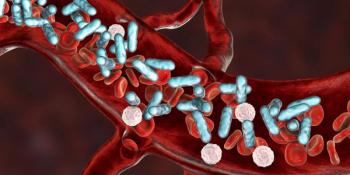
- Oncology Vol 28 No 1S
- Volume 28
- Issue 1S
(P054) Stereotactic Body Radiation Therapy as Salvage for Intrathoracic Recurrence After Definitive Stereotactic Body Radiation Therapy for Early-Stage Non–Small-Cell Lung Cancer
Despite the success of stereotactic body radiotherapy (SBRT) as a treatment modality for early-stage non–small-cell lung cancer (NSCLC), some patients develop localized intrathoracic recurrences after treatment. Effective salvage therapy for these patients has typically been limited. We examine our institutional experience using SBRT for salvage of intrathoracic recurrence after definitive SBRT for early-stage NSCLC.
Megan A. Mezera, MD, MS, Mahesh Chandrasekhar, BS, Goetz Kloecker, MD, MBA, MSPH, FACP, Victor van Berkel, MD, Michael Bousamra, MD, Neal E. Dunlap, MD; James Graham Brown Cancer Center, University of Louisville
Purpose: Despite the success of stereotactic body radiotherapy (SBRT) as a treatment modality for early-stage non–small-cell lung cancer (NSCLC), some patients develop localized intrathoracic recurrences after treatment. Effective salvage therapy for these patients has typically been limited. We examine our institutional experience using SBRT for salvage of intrathoracic recurrence after definitive SBRT for early-stage NSCLC.
Materials and Methods: We examined 82 consecutive medically inoperable patients treated with definitive SBRT for early-stage NSCLC between 2009 and 2012; 94% of patients had biopsy-proven disease. Median prescribed dose was 50 Gy (range: 42–60 Gy) in three to five fractions. Median biologic equivalent dose (BED) was 100 Gy (range: 78–180 Gy). Recurrence was defined clinically by Response Evaluation Criteria in Solid Tumors (RECIST), fluorodeoxyglucose–positron emission tomography (FDG-PET), or pathologic diagnosis. Local recurrence was defined as recurrence within the treated lobe of the lung. Regional recurrence was defined as recurrence in the ipsilateral untreated lobe, ipsilateral hilum, or mediastinal lymph nodes. Metastatic recurrence was defined as recurrence in the contralateral hemithorax or distant disease.
Results: Median follow-up from completion of treatment was 20 months (range: 6.0–40.3 mo). Estimated median survival was 29.2 months (range: 1–40.3 mo). Estimated 2-year overall survival (OS) was 65%. Two-year local recurrence, regional recurrence, and distant metastatic rates were 11%, 13%, and 28%, respectively. Sixteen patients experienced either local or regional recurrence, nine of whom underwent SBRT for salvage at a median of 10.0 months from completion of initial definitive SBRT (range: 2.6–16.6 mo). Median salvage dose was 50 Gy (range: 40–54 Gy) with median biologically effective dose (BED) of 100 Gy (range: 72–151 Gy). Treatment was well tolerated, with two patients experiencing grade 2 pneumonitis, one patient experiencing grade 3 chest wall pain, and one patient with rib fracture. At a median of 10 months from completion of salvage, the salvage site remained controlled in all patients (range: 3.0–18.1 mo). OS was compared between three subgroups: no local regional failure (n = 68), local regional failure without salvage (n = 5), and local regional failure with salvage by SBRT (n = 9). Estimated median survival was 31.3 months, 14.3 months, and 29.9 months, respectively (P = .007). Estimated 2-year OS was 78%, 50%, and 80%, respectively. Survival was statistically significantly lower in patients experiencing local regional failure without salvage when compared with those salvaged by SBRT (P = .007). There was no difference in survival between those without local regional failure and those with local regional failure salvaged by SBRT (P = .783).
Conclusion: Although follow-up after salvage SBRT is relatively short (median 10 months), effective salvage was achieved for both in-field and out-of-field recurrences, with no evidence of progression to date. OS was improved in patients undergoing salvage to rates equivalent to those in patients who did not experience local regional failure (29.9 vs 31.3 mo; P = .783). Early results for SBRT in the salvage setting for local regional recurrences after definitive SBRT for early-stage NSCLC appear favorable for appropriately selected patients when used cautiously with close follow-up.
Articles in this issue
Newsletter
Stay up to date on recent advances in the multidisciplinary approach to cancer.

















































































